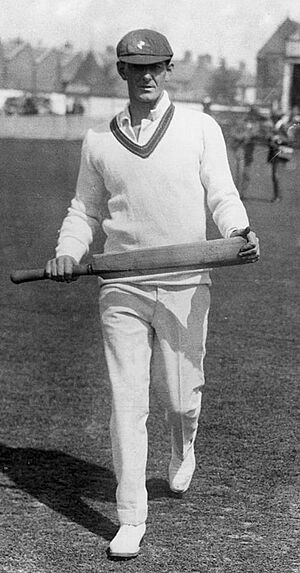Ted McDonald facts for kids
Quick facts for kids
Ted McDonald
|
||||||||||||||||||||||||||||||||||||||||||||||||||||||||||||||||||||||||
|---|---|---|---|---|---|---|---|---|---|---|---|---|---|---|---|---|---|---|---|---|---|---|---|---|---|---|---|---|---|---|---|---|---|---|---|---|---|---|---|---|---|---|---|---|---|---|---|---|---|---|---|---|---|---|---|---|---|---|---|---|---|---|---|---|---|---|---|---|---|---|---|---|
 |
||||||||||||||||||||||||||||||||||||||||||||||||||||||||||||||||||||||||
| Born |
Edgar Arthur McDonald
6 January 1891 Launceston, Tasmania, Australia
|
|||||||||||||||||||||||||||||||||||||||||||||||||||||||||||||||||||||||
| Died | 22 July 1937 (aged 46) Blackrod, Lancashire, England
|
|||||||||||||||||||||||||||||||||||||||||||||||||||||||||||||||||||||||
|
||||||||||||||||||||||||||||||||||||||||||||||||||||||||||||||||||||||||
|
||||||||||||||||||||||||||||||||||||||||||||||||||||||||||||||||||||||||
Ted McDonald (born January 6, 1891 – died July 22, 1937) was a talented Australian sportsman. He was famous for playing both cricket and Australian rules football. Ted played cricket for teams like Tasmania, Victoria, Lancashire, and even for the Australian national team. Before focusing only on cricket, he also played Australian rules football for Launceston Football Club, Essendon Football Club, and Fitzroy Football Club. Even though his international cricket career was short, many people thought he was one of the best fast bowlers of his time.
Contents
Ted McDonald's Cricket Journey
Ted McDonald was a very fast bowler. He could make the ball move in tricky ways, even on pitches that were usually easy to play on. In 1921, he became a surprise star during Australia's cricket tour in England. Ted and another bowler, Jack Gregory, were a powerful team. They made it very hard for the English batsmen to score runs. For example, one player, John Evans, was said to be very nervous when he had to bat against them. Another player, Andy Ducat, had his bat broken by Ted's fast bowling! Jack Gregory could make the ball swing, while Ted McDonald made it move sharply off the ground. Together, they were amazing, taking 46 wickets in that series.
Early Cricket Days
Before World War I, Ted played a few matches for Victoria. But he really started to shine right after the war. In one state match, he took eight wickets in a single innings. This great performance helped him get picked for the Australian team. He played in three Test matches against England in the 1920–21 series. Australia won that series 5–0. However, Ted didn't have much success in those first Test matches. His six wickets cost 65 runs each.
Success in England
The next summer, in England, Ted became a huge success. He took eight wickets in the first Test match at Trent Bridge. He also played a big part in Australia's wins at Lord's and Headingley. These wins helped Australia win the series. Because of his great performances in 1921, Ted McDonald was named a Wisden Cricketer of the Year in 1922. This is a special award in cricket.
Moving to Professional Cricket
After the tour in England, Ted played three more Test matches against South Africa in 1921–22. These were his last Test matches. All his international cricket was played within the year 1921. After that, he decided to become a professional player for a club called Nelson in the Lancashire League.
Playing for Lancashire
By 1924, Ted was allowed to play for Lancashire. At first, he could only play in midweek games because of his club commitments. Again, he was a sensation! In his first full season, 1925, he took an incredible 205 wickets. From 1926 to 1930, Lancashire won the County Championship four times. This was the most successful time in the county's history. Overall, Ted took 1053 wickets for Lancashire. He was so valuable that he received a "benefit" in 1929. This was a special payment, given to him very quickly after only five seasons with the county.
End of His Cricket Career
Ted's first-class career ended quite suddenly. His performance dropped a bit in 1930, but he still took over 100 wickets. However, in 1931, he lost his form almost completely. He only took 26 wickets all season and was left out of half the county's matches. At the end of that season, he went back to play in the Lancashire League for a team called Bacup.
Ted McDonald's Football Career
Besides cricket, Ted McDonald also played Australian rules football. He played for the Launceston team. He also played two matches for Essendon Football Club in 1912. From 1913 to 1919, he played 46 matches for Fitzroy Football Club.
Ted McDonald's Passing
Ted McDonald died when he was 46 years old. His car was in an accident with another car near Bolton, England. This happened on the morning of July 22, 1937.

